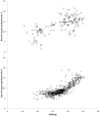Measuring energy expenditure in sub-adult and hatchling sea turtles via accelerometry
- PMID: 21829613
- PMCID: PMC3150346
- DOI: 10.1371/journal.pone.0022311
Measuring energy expenditure in sub-adult and hatchling sea turtles via accelerometry
Abstract
Measuring the metabolic of sea turtles is fundamental to understanding their ecology yet the presently available methods are limited. Accelerometry is a relatively new technique for estimating metabolic rate that has shown promise with a number of species but its utility with air-breathing divers is not yet established. The present study undertakes laboratory experiments to investigate whether rate of oxygen uptake (VO2) at the surface in active sub-adult green turtles Chelonia mydas and hatchling loggerhead turtles Caretta caretta correlates with overall dynamic body acceleration (ODBA), a derivative of acceleration used as a proxy for metabolic rate. Six green turtles (25-44 kg) and two loggerhead turtles (20 g) were instrumented with tri-axial acceleration logging devices and placed singly into a respirometry chamber. The green turtles were able to submerge freely within a 1.5 m deep tank and the loggerhead turtles were tethered in water 16 cm deep so that they swam at the surface. A significant prediction equation for mean VO2 over an hour in a green turtle from measures of ODBA and mean flipper length (R(2) = 0.56) returned a mean estimate error across turtles of 8.0%. The range of temperatures used in the green turtle experiments (22-30 °C) had only a small effect on Vo₂. A VO2-ODBA equation for the loggerhead hatchling data was also significant (R(2) = 0.67). Together these data indicate the potential of the accelerometry technique for estimating energy expenditure in sea turtles, which may have important applications in sea turtle diving ecology, and also in conservation such as assessing turtle survival times when trapped underwater in fishing nets.
Conflict of interest statement
Figures





References
-
- Jones T, Reina R, Darveau CA, Lutz P. Ontogeny of energetics in leatherback (Dermochelys coriacea) and olive ridley (Lepidochelys olivacea) sea turtle hatchlings. Comparative Biochemistry and Physiology A. 2007;147:313–322. - PubMed
-
- Jones T, Hastings M, Bostrom B, Andrews RD, Jones D. Validation of the use of doubly labelled water for estimating metabolic rate in the green turtle (Chelonia mydas L.): a word of caution. Journal of Experimental Biology. 2009;212:2635–2644. - PubMed
-
- Wallace B, Williams C, Paladino F, Morreale S, Todd Lindstrom R, et al. Bioenergetics and diving activity of internesting leatherback turtles Dermochelys coriacea at Parque Nacional Marino Las Baulas, Costa Rica. Journal of Experimental Biology. 2005;208:3873–3884. - PubMed
-
- Butler PJ, Green JA, Boyd IL, Speakman JR. Measuring metabolic rate in the field: the pros and cons of the doubly labelled water and heart rate methods. Functional Ecology. 2004;18:168–183.
-
- Southwood AL, Reina R, Jones V, Speakman JR, Jones D. Seasonal metabolism of juvenile green turtles (Chelonia mydas) at Heron Island, Australia. Canadian Journal of Zoology. 2006;84:125–135.
Publication types
MeSH terms
Substances
LinkOut - more resources
Full Text Sources

